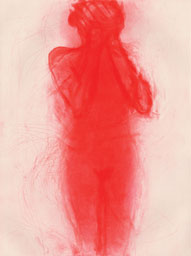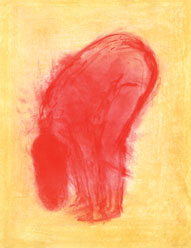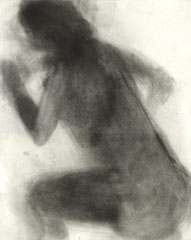

|
|
An artist's artist, Garache was first recommended to AimZ Maeght, the most important art-dealer in post-war France, by two of Maeght's most important artists, Joan Mir— and Marc Chagall. Living and working in Paris, Claude Garache (b. 1930) has achieved a balance of surprise and inevitability (the blending of an individual talent and a viable tradition) that marks the works of Degas and Matisse, Derain and Giacometti. Looking at Garache's oeuvre, we recognize works that immediately proclaim themselves as "classic," yet, which are more disturbing than we expect classic art to be. Rather than confronting the source of this disturbance, it is tempting to concentrate instead on Garache's technical virtuosity. As a painter, Garache is a perfectionist, layering on wash after wash of color, building up depth and intensity, establishing both a ground and an almost 3-dimensional shape looming out of that ground. Garache is an established master of the aquatint, whose graphics are regularly included in the Bibliotheque Nationale’s five-year surveys of the most important work in prints and were similarly included in shows at the Museum of Modern Art in New York, the Fifth European Print Bienniale, and have been featured in one-person shows at museums and galleries in the U.S., Belgium, England, France, Germany, and Spain. He is also a superb lithographer, whose sense of color and texture produces fascinating and compelling studies of the human figure, his only subject. Garache, however, seems to see a present which does not deny the ultimate inescapable vulnerability of his subjects yet which is not without hope. The female body, whether depicted in paint, charcoal, crayon, aquatint, or lithograph, has become in his works the symbol through which we can understand Garache’s view of the human condition. Relentlessly yet lovingly, he explores the beauty and the pain of human experience through the image of the nude. His works, as Georges Barriere observed in Chroniques de l'Art Vivant (May-June, 1975), “achieve the resonance of a beautiful poem or psalm through repeated incantations of the one theme... which, through an infinite series of comparisons, symbolizes rebirth." Whether withdrawn into themselves for protection or contemplation, lying tensely or languorously, leaping up from depths we cannot imagine or falling into a void whose bottom is not evident, fleeing from sights we would not necessarily desire to see or running joyfully towards a destination we cannot yet see, his subjects exist in a world which we are compelled to acknowledge as our own. His art shows us people with a fear of the past and doubts about the future who nonetheless join to that a willingness to exist in the present and often to joy in that existence. Claude Garache offers us x-rays of the psyche, ultra-sound scans of a womb-like world in which the acknowledgment of universal vulnerability may be a necessity for survival as well as a threat to it. These works invite us to imagine a world in which we do not have to make ourselves stone-hard to endure, perhaps even a world where our sense of the limits of the human can keep us exultantly and ecstatically whole. Garache's image remains the female nude. Garache, whom Dora Vallier has called the first post-abstract master of the nude, said in an interview with critic Jacob Stockinger, "My women are genderless. They are human beings, they represent all people.” His works continue to assert the strength of openness, a strength arising out of a recognition of the mutualityŃeven the universality of vulnerability and out of the freedom that accompanies that recognition. Stockinger suggests that "Once viewers have seen his work, they are unlikely to forget the style. To the degree that he has fashioned at least his own visual language, and that viewers are not likely to confuse his work with anybody else’s, he admits success." No one who has seen his work is likely to mistake these for the work of any other artist, and once they have seen these powerful and joyful new works they are unlikely to forget them. With the publication in 1988 of Jean Starobinski's important book on Garache (published by Flammarion) with texts in both French and English, Garache's work has become more accessible to English-speaking audiences. As Richard Stamelman, whose perceptive essay on Garache is featured in the catalog of the Wesleyan University retrospective of Garache's prints, observes, Garache's "art suggests that he sees the body as a way of being in the world, of existing in concert with the rhythms of living and dying that modulate human activity, and of engaging with and reaching out to the corporeal reality of other human beings. For Garache, the body (or, more pointedly, what he describes as 'the precariousness, the fragility, of this marvel, this magnificent being, that is the human body') is a place of passage and of momentary coalescence where ‘the Real’ becomes visible." |
![]()

Dos Debot
Etching on arches
65 x 50 cm

Ocre II
Etching on arches
81.2 x 62 cm

Stanton III
Etching
65 x 50 cm